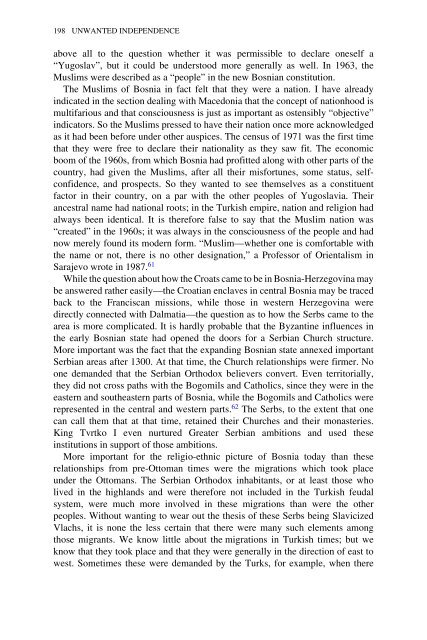Yugoslavia: A History of its Demise - Indymedia
Yugoslavia: A History of its Demise - Indymedia
Yugoslavia: A History of its Demise - Indymedia
Create successful ePaper yourself
Turn your PDF publications into a flip-book with our unique Google optimized e-Paper software.
198 UNWANTED INDEPENDENCE<br />
above all to the question whether it was permissible to declare oneself a<br />
“Yugoslav”, but it could be understood more generally as well. In 1963, the<br />
Muslims were described as a “people” in the new Bosnian constitution.<br />
The Muslims <strong>of</strong> Bosnia in fact felt that they were a nation. I have already<br />
indicated in the section dealing with Macedonia that the concept <strong>of</strong> nationhood is<br />
multifarious and that consciousness is just as important as ostensibly “objective”<br />
indicators. So the Muslims pressed to have their nation once more acknowledged<br />
as it had been before under other auspices. The census <strong>of</strong> 1971 was the first time<br />
that they were free to declare their nationality as they saw fit. The economic<br />
boom <strong>of</strong> the 1960s, from which Bosnia had pr<strong>of</strong>itted along with other parts <strong>of</strong> the<br />
country, had given the Muslims, after all their misfortunes, some status, selfconfidence,<br />
and prospects. So they wanted to see themselves as a constituent<br />
factor in their country, on a par with the other peoples <strong>of</strong> <strong>Yugoslavia</strong>. Their<br />
ancestral name had national roots; in the Turkish empire, nation and religion had<br />
always been identical. It is therefore false to say that the Muslim nation was<br />
“created” in the 1960s; it was always in the consciousness <strong>of</strong> the people and had<br />
now merely found <strong>its</strong> modern form. “Muslim—whether one is comfortable with<br />
the name or not, there is no other designation,” a Pr<strong>of</strong>essor <strong>of</strong> Orientalism in<br />
Sarajevo wrote in 1987. 61<br />
While the question about how the Croats came to be in Bosnia-Herzegovina may<br />
be answered rather easily—the Croatian enclaves in central Bosnia may be traced<br />
back to the Franciscan missions, while those in western Herzegovina were<br />
directly connected with Dalmatia—the question as to how the Serbs came to the<br />
area is more complicated. It is hardly probable that the Byzantine influences in<br />
the early Bosnian state had opened the doors for a Serbian Church structure.<br />
More important was the fact that the expanding Bosnian state annexed important<br />
Serbian areas after 1300. At that time, the Church relationships were firmer. No<br />
one demanded that the Serbian Orthodox believers convert. Even territorially,<br />
they did not cross paths with the Bogomils and Catholics, since they were in the<br />
eastern and southeastern parts <strong>of</strong> Bosnia, while the Bogomils and Catholics were<br />
represented in the central and western parts. 62 The Serbs, to the extent that one<br />
can call them that at that time, retained their Churches and their monasteries.<br />
King Tvrtko I even nurtured Greater Serbian ambitions and used these<br />
institutions in support <strong>of</strong> those ambitions.<br />
More important for the religio-ethnic picture <strong>of</strong> Bosnia today than these<br />
relationships from pre-Ottoman times were the migrations which took place<br />
under the Ottomans. The Serbian Orthodox inhabitants, or at least those who<br />
lived in the highlands and were therefore not included in the Turkish feudal<br />
system, were much more involved in these migrations than were the other<br />
peoples. Without wanting to wear out the thesis <strong>of</strong> these Serbs being Slavicized<br />
Vlachs, it is none the less certain that there were many such elements among<br />
those migrants. We know little about the migrations in Turkish times; but we<br />
know that they took place and that they were generally in the direction <strong>of</strong> east to<br />
west. Sometimes these were demanded by the Turks, for example, when there
















